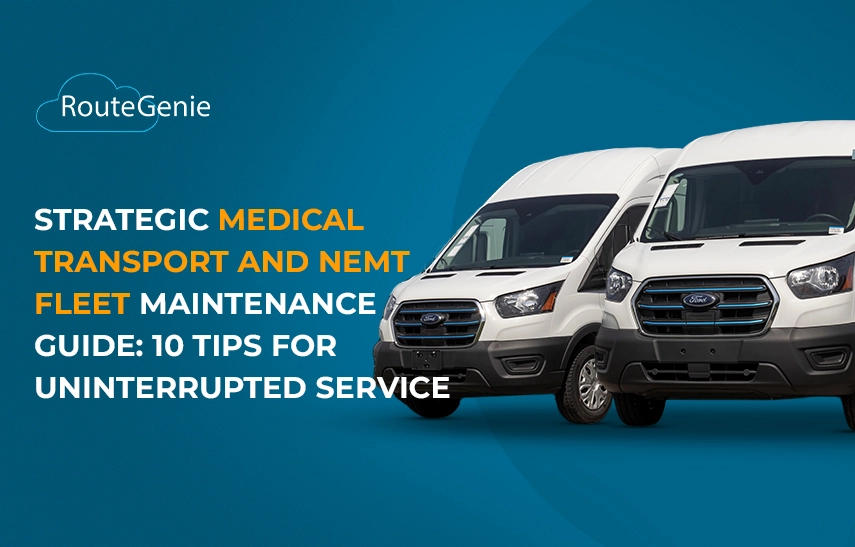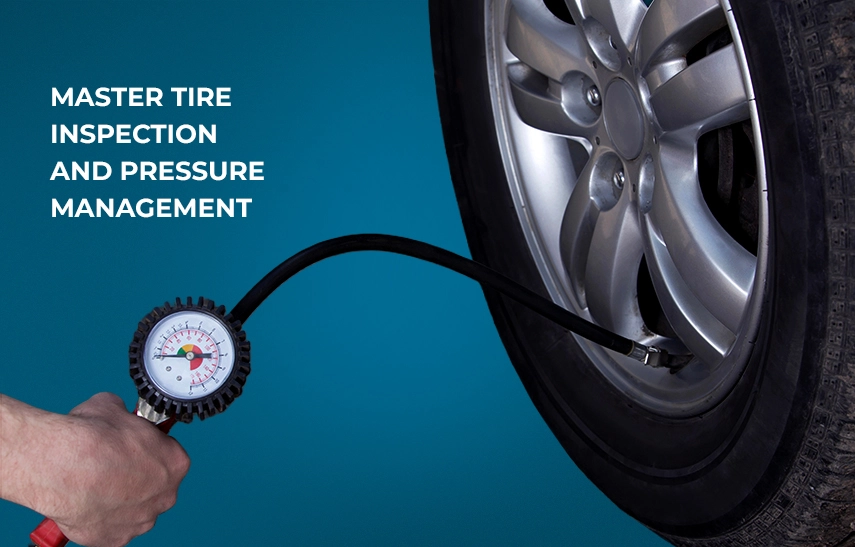Top 10 Tips for Uninterrupted Medical Transportation and NEMT Service: Strategic Fleet Maintenance Guide

We have already answered the question of why keep medical transport vehicles well-maintained, but how can it be done? This comprehensive guide presents ten proven strategies that NEMT operators should follow to maintain fleet reliability while optimizing costs. These are battle-tested approaches that help medical transportation providers prevent unexpected vehicle breakdowns while significantly reducing maintenance costs.
Whether you're running a single van or managing a large fleet, these strategies will help. They'll build the foundation for sustainable, profitable operations serving your community's most vulnerable passengers.
Contents:
- Top 10 Tips for Medical Transport and NEMT Fleet Maintenance
- Implement the Maintenance Strategy for Immediate Benefits
Top 10 Tips for Medical Transport and NEMT Fleet Maintenance
-
Create a Strict Schedule and Stick to It
Effective Medical fleet maintenance begins with structured scheduling. This same principle applies to medical transportation fleets working under healthcare contracts or health plan networks. Your goal is to shift from reacting to crises to following a predictable, cost-controlled plan. Your exact maintenance schedule depends on fleet composition, manufacturer recommendations, daily mileage, and vehicle condition. However, you should keep in mind that medical vans do not experience standard driving conditions. Providers cover roughly 100 miles daily with frequent stop-and-go traffic and lots of idling. These conditions require more frequent maintenance. Here is an estimated breakdown for a full servicing schedule, but you can also check out RouteGenie’s full medical transport maintenance schedule.
At-a-Glance Maintenance Timeline
- Daily (approximately 100-mile intervals): Inspect tires, fluid levels, brakes, lights, safety equipment, and ADA equipment. Sanitize the vehicle interior. Check for leaks and damage.
- Weekly (500-mile intervals): Check tire pressures, clean battery terminals, inspect belts and hoses, top off washer fluid, inspect cabin filters, and address any DVIR issues.
- Monthly (2,000-3,000-mile intervals): Perform oil change (conventional); inspect filters; check exhaust; service lifts; check ADA equipment.
- Quarterly (6,000-7,500-mile intervals): Oil change if not done earlier with synthetic; rotate tires; check brakes, coolant, and suspension; load-test ADA systems.
- Annual (24,000-mile/ 12-month intervals): DOT inspection; brake fluid flush; service transmission; chassis inspection; inspect lift hydraulics; check spark plugs; check of all belts and hoses; wheel alignment.
- Seasonal: Winter. Check tires, heater, wipers, antifreeze, battery, inspect undercarriage set up above. Summer. Check tires, air conditioning, cooling system, wipers.
- Battery: Replace every three to five years. Stress test after three years in use and especially before the winter season.
- Tires: Replace tires every 25,000 - 50,000 miles or six years from date of manufacture if under 25,000 miles in usage.
Electric Vehicles: No oil changes (some EV models might require reduction gear oil change every 50K miles); very low brake pad wear due to regenerative braking, but brake fluid replacement is still required as per the vehicle maintenance schedule; faster tire wear requires more frequent tire rotation; check cooling/charging systems; monitor traction battery SoH.
-
Technology Solutions Help with Vehicle Maintenance Tracking and Provide Measurable Returns
![]() Is there a way to transform maintenance from reactive guesswork to a proactive strategy? The answer is a definitive yes. Modern medical transport and NEMT fleet management software platforms, like RouteGenie, support providers working with health plans and brokers. It monitors compliance and reporting requirements automatically. Software can track vehicle performance, automate maintenance scheduling, and provide real-time alerts for oil changes, tire rotations, brake inspections, and regulatory compliance deadlines. This data-driven approach to servicing your fleet has quantifiable benefits:
Is there a way to transform maintenance from reactive guesswork to a proactive strategy? The answer is a definitive yes. Modern medical transport and NEMT fleet management software platforms, like RouteGenie, support providers working with health plans and brokers. It monitors compliance and reporting requirements automatically. Software can track vehicle performance, automate maintenance scheduling, and provide real-time alerts for oil changes, tire rotations, brake inspections, and regulatory compliance deadlines. This data-driven approach to servicing your fleet has quantifiable benefits:
- Route optimization can reduce deadhead miles by up to 10-20%
- Automated maintenance alerts prevent missed services
- Real-time tracking enables proactive maintenance planning
- Direct mechanic access to complete vehicle maintenance history
- Streamlined warranty claims and repair decision-making
-
Train Drivers in Preventive Maintenance Awareness: Prioritize DVIRs and Reward Efforts in Self-Maintenance
Driver training in preventative maintenance awareness significantly reduces vehicle problems. Even the most basic skills can extend equipment life and improve safety performance. Drivers spend the most time with vehicles and can identify developing issues long before they reach the shop for diagnostics. Train them to recognize warning signs like unusual noises, vibrations, warning lights, or performance changes. This way, major problems do not turn into expensive emergency repairs or safety hazards.
DVIR (Driver Vehicle Inspection Report) is a non-negotiable procedure for legal compliance, safety, and uptime. Your medical transport company should treat these reports as the first line of defense against breakdowns. Documented inspections catch faults before service. They create a compliance trail and trigger proactive repairs instead of costly road calls. Require your employees to take photo notes for issues (e.g., uneven tire wear, fluid spots, loose securement), and route DVIR findings automatically to dispatch/maintenance for same-day triage.
Cleaning & sanitation do not seem like the factors that will prolong the life of your NEMT vans, but the devil is in the details. Having clean safety sensors, windows, and lights means a greater likelihood of fewer accidents, while clean cabins help keep your passengers safe (fewer slip/trip hazards). Clean vehicles make maintenance easier. You can spot leaks, frayed belts, cracked hoses, and lift/ramp wear before they become problems. Last, cleanliness also protects your brand. One dirty ride can risk not getting a contract, because medical transport passengers are often immunocompromised and need to be in a clean cabin environment to minimize infection potential.
Design KPIs and incentives around predictive maintenance. Set clear targets for your drivers about the maintenance procedures. You should reward those who constantly uphold the cleanliness standards and show reliable performance of entrusted vehicles and equipment.
-
Master Tire Inspection and Pressure Management
 Tires are your vehicle's only road contact. A flat tire causes downtime. A tire blowout creates a serious safety risk for your passengers. The Department of Transportation. The Department of Transportation mandates the front tires to have at least 4/32” tread depth and all other tires to have at least 2/32” tread depth as the legal minimum. Since those are the absolute minimum requirements, it is best to decide on changing tires in advance.
Tires are your vehicle's only road contact. A flat tire causes downtime. A tire blowout creates a serious safety risk for your passengers. The Department of Transportation. The Department of Transportation mandates the front tires to have at least 4/32” tread depth and all other tires to have at least 2/32” tread depth as the legal minimum. Since those are the absolute minimum requirements, it is best to decide on changing tires in advance.
Mileage: The majority of tires last 25,000–50,000 miles before they need to be replaced.
Age: Replace at ~6 years regardless of miles; 10 years max from manufacture date, even if they look new.
Condition: Replace immediately if you see sidewall cracks, bulges, cords showing, punctures near sidewall, chronic vibration, or uneven wear (fix alignment/suspension too).
Rotation: Rotate every 5,000-8,000 miles for even wear.
Weekly tire inspections: Every week, visually assess for cuts, abrasions, exposed steel, tread separation, or uneven wear patterns. Shoulder step wear, "river wear," or center wear indicate alignment, suspension, or pressure issues. Run your hand along tire surfaces to detect feathering or cupping. These features suggest mechanical problems that require immediate attention.
Tire pressure: Maintain the pressures recommended on the door-jamb placard. Carry out routine checking when the tires are cold to get an accurate pressure reading. Check pressure when tires are cold for accurate readings. A tire that is under-inflated will wear the tread on the outer edges and generate more heat, which has the potential to blow out while driving. Overinflated tires wear prematurely in the middle and reduce road contact. This decreases braking and handling performance.
Seasonal tire considerations (matters in cold climates).
- Winter tires provide superior traction below 45°F
- All-season and especially all-weather tires (certified with the Mountain Snowflake symbol) perform adequately in moderate conditions
- Summer tires ensure ideal traction during hotter seasons.
-
Prioritize Comprehensive Brake System Checks
Brake systems directly protect passenger lives and limit business liability. Verify brakes daily, inspect weekly, and service regularly.
- A daily brake verification typically includes pedal response testing, parking brake functionality, and unusual noise identification.
- Weekly inspections should examine brake fluid levels, brake line condition, and any visible wear on accessible components.
- Professional service: a qualified technician should assess pads, rotors, fluid, hydraulic system integrity, and lines every 12-15k miles or annually (sooner for heavy-duty vehicles).
- Urgent warning signs: Dashboard brake warning lights on; squealing or grinding noises; vibration/pulsing; spongy brake pedal; burning/chemical smell; pulling to one side or longer stopping distance → park and send to a tech.
-
Implement Strategic Oil Change Scheduling
Oil Change Guidelines for NEMT Vehicles
Modern engines no longer follow the blanket 3,000-mile rule. Service is needed every 3,000–15,000 miles, depending on engine design, oil type, and driving conditions. Always follow your vehicle's manual to avoid voiding warranties and damaging your engine.
However, we cannot ignore the fact that medical transport and NEMT vehicles face harsher conditions than typical passenger cars. Medical vans experience constant stop-and-go city driving, extended idling during patient loading, frequent short trips, and heavy air-conditioning use. These driving patterns all accelerate oil degradation and shorten its protective lifespan, since engines do not reach optimal operating temperatures.
Hence, it is crucial for NEMT providers to be strategic about oil change intervals, rather than simply relying on the mileage interval recommended by the manufacturer. When vehicles experience primarily urban stop-and-go traffic or extended idling situations, cut the intervals by 20-30% and consider oil changes with new filters.
Why it is important: The oil in your vehicles lubricates, cools, removes sludge, and keeps the engine sealed. In a medical transport or NEMT fleet, reasonable engine reliability is critical for patient safety and for being able to provide continual service.
Warning signs that an oil change is needed:
- Dark or dirty oil
- Knocking or rattling from the engine
- Decrease in fuel efficiency
- Unexpected exhaust smoke
- Vehicles stalling, shifting problems, or dashboard alerts
- Intervals based on oil type: (Adjusted for NEMT service)
Conventional oil: approximately 3,000 miles for normal driving. In city traffic or with frequent idling, shorten to 2,000–2,500 miles.
Synthetic blend: normally 5,000–7,500 miles. Shorten to 4,000–5,000 miles in severe-duty conditions.
Full synthetic: typically 7,500+ miles. Shorten to 6,000–7,000 miles if vehicles idle extensively or run short routes.
-
12-Volt Battery Tip: Don’t Overlook a Small but Critical Component
One of the most common and disruptive failures in the NEMT business comes from the 12-Volt battery. Unlike tires or brakes, these batteries often fail suddenly once they reach the end of their lifespan, leaving drivers stranded with patients on board.
Best practices for 12-V batteries:
- Replace every three to five years, even if the vehicle still starts reliably.
- Once your battery is three years old, load-test annually to detect weakening performance before failure.
- Inspect and clean terminals regularly to prevent corrosion.
- Monitor more closely in extreme heat or cold, or if vehicles power heavy ADA and medical equipment.
- Avoid leaving vehicles unused for long periods, which accelerates discharge and shortens battery life.
Proactively replacing aging 12-V batteries reduces the risk of unexpected service disruptions, protects patient safety, and keeps NEMT fleets compliant and dependable.
-
Professional Maintenance for Complex Systems and NEMT Equipment
 You can perform routine inspections in-house. However, leave engine, transmission, chassis, and advanced brake repairs to qualified technicians—attempting these without experience is costly and unsafe.
You can perform routine inspections in-house. However, leave engine, transmission, chassis, and advanced brake repairs to qualified technicians—attempting these without experience is costly and unsafe.
Also, Non-Emergency Medical Transportation (NEMT) vehicles and many medical transportation vehicles serving hospitals and health plans typically have medical and accessibility equipment that requires specialized maintenance:
- Wheelchair lifts require daily driver checks, professional inspections every 750–1,500 cycles, and annual hydraulic service.
- Medical equipment (stretchers, oxygen units) needs daily function checks, oxygen tanks need monthly inspections, and annual testing per Joint Commission and CMS standards.
- Securement systems and securement points (e.g., Q’STRAINT) must be regularly tested and approved for compliance.
Professional servicing ensures patient safety, maintains ADA compliance, and protects providers from liability or contract penalties.
-
Medical Transport Fleet Size Determines Optimal Maintenance Strategies
The size of your fleet determines the approach that your company should take to the maintenance procedures. Smaller operations cannot afford in-house mechanics, while larger ones can significantly reduce expenses if they service the fleet directly at the home base.
Small NEMT operators (1-5 vehicles) benefit from simpler business processes but lack bulk purchasing power or specialized tools to take care of the passenger vehicles on their own. Under such circumstances, they should follow manufacturer maintenance schedules and partner with trusted local mechanics familiar with NEMT operations' needs. A great tool that can somewhat substitute monitoring by a professional mechanic is digital inspection apps.
Medium fleets (6-20 vehicles) can benefit from a hybrid approach. About 75% of routine work can be handled in-house, while complex repairs can be outsourced. This balances out cost control, but you will have to regularly resort to the expert services nonetheless.
Large fleets (21+ vehicles) can justify hiring automotive experts for the fastest repairs. Dedicated maintenance staff have direct access to the fleet and do firsthand repairs without the need to make an appointment weeks in advance. Moreover, a larger company qualifies for bulk parts purchasing.
Operators in the 5-10 vehicle range often face a transition stage: they are not large enough to maintain full-time staff, yet too small for simple outsourcing. In this scenario, strategic partnerships with specialized NEMT maintenance providers fill this gap.
-
Track Total Cost of Ownership (TCO) and Be Ready to Let Go of the Vehicle
Total Cost of Ownership analysis determines optimal vehicle replacement timing. By comparing ongoing maintenance costs to replacement benefits, you can determine whether to sell the vehicle and buy a new medical van. High-mileage vehicles approaching 200,000-250,000 miles often reach a point where major repairs (engines, transmissions, wheelchair lifts) cost more than buying new.
How would you know that a vehicle needs to be replaced? Watch out for these signs:
- Annual maintenance costs exceed 50% of vehicle value
- Frequent breakdowns disrupt service reliability
- Inability to find replacement parts for older systems
- Outdated technology is affecting operational efficiency
- Safety system limitations compared to modern alternatives
- Fuel efficiency is significantly below current standards
Implement the Maintenance Strategy for Immediate Benefits
NEMT and medical transport entrepreneurs can implement these maintenance strategies immediately for measurable results. The first step they should take is to embrace automated maintenance scheduling using fleet management software RouteGenie. With the data on hand, medical transport providers can establish comprehensive preventive maintenance protocols, train drivers on proper procedures, and document all activities digitally for regulatory compliance and performance tracking.
About the author

Serhii Taborovskyi is the creator and author of the Automotive Territory YouTube Channel, with 300,000 subscribers and counting. He is an avid automotive enthusiast and a fan of any and all motorized vehicles. Serhii is a visiting author at RouteGenie, sharing his expertise for the benefit of the NEMT community.
The author assumes no responsibility or liability for any errors or omissions in the content of this site. The information contained in this site is provided on an "as is" basis with no guarantees of completeness, accuracy, usefulness or timeliness.